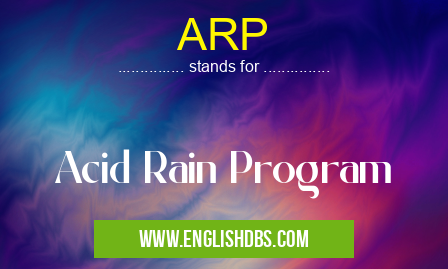What does ARP mean in CHEMISTRY
ARP (Acid Rain Program) is an environmental initiative implemented in the United States to reduce the emissions of sulfur dioxide (SO2) and nitrogen oxides (NOx), which contribute to the formation of acid rain.

ARP meaning in Chemistry in Academic & Science
ARP mostly used in an acronym Chemistry in Category Academic & Science that means Acid Rain Program
Shorthand: ARP,
Full Form: Acid Rain Program
For more information of "Acid Rain Program", see the section below.
Meaning and Definition
ARP stands for Acid Rain Program. It is a comprehensive program designed to address the issue of acid rain, which is caused by the release of sulfur dioxide and nitrogen oxides into the atmosphere. These pollutants react with water vapor in the atmosphere to form sulfuric and nitric acids, which then fall to the ground as acid rain or snow.
Key Aspects of ARP
- Established in 1990: The Acid Rain Program was established under the Clean Air Act Amendments of 1990.
- Phased Implementation: The program was implemented in two phases, beginning with Phase I in 1995 and Phase II in 2000.
- Cap-and-Trade System: ARP implemented a cap-and-trade system, which sets a maximum limit on the total emissions of SO2 and NOx from affected sources.
- Allowance Allocation: Each source receives a specific number of allowances, which represent the amount of pollution it is permitted to emit.
- Trading of Allowances: Sources can trade allowances with each other, allowing them to meet their emission targets in the most cost-effective manner.
Benefits of ARP
- Reduced Emissions: ARP has significantly reduced SO2 and NOx emissions in the United States, contributing to improved air quality.
- Improved Environmental Health: Reduced acid rain has resulted in improved water quality, protected forests, and reduced damage to buildings and infrastructure.
- Economic Benefits: The program has also generated economic benefits by creating jobs and stimulating investment in clean energy technologies.
Essential Questions and Answers on Acid Rain Program in "SCIENCE»CHEMISTRY"
What is the Acid Rain Program (ARP)?
The Acid Rain Program is a market-based program established by the Clean Air Act Amendments of 1990 to reduce emissions of sulfur dioxide (SO2) and nitrogen oxides (NOx) from electric power plants. The goal is to mitigate the harmful effects of acid rain, which can damage forests, lakes, and buildings.
How does the ARP work?
The ARP sets limits on emissions of SO2 and NOx from power plants and requires them to obtain allowances for each ton of emissions. Allowances are tradable, allowing power plants to buy and sell allowances to meet their emission limits. This creates a market incentive for power plants to reduce their emissions cost-effectively.
What is the impact of the ARP on air pollution?
The ARP has significantly reduced SO2 and NOx emissions from power plants. Since its implementation, SO2 emissions have decreased by more than 65%, and NOx emissions have decreased by over 50%. This has resulted in a substantial reduction in acid rain and its associated environmental impacts.
What are the benefits of the ARP?
The ARP has numerous benefits, including:
- Improved air quality, leading to reduced respiratory illnesses and other health problems.
- Reduced damage to forests, lakes, and buildings from acid rain.
- Economic incentives for businesses to invest in clean energy technologies.
- Creation of a market for emissions trading, providing flexibility and cost-effectiveness.
What are the challenges associated with the ARP?
While the ARP has been successful in reducing acid rain, it has also faced some challenges:
- Managing the cap-and-trade system to ensure it remains effective and equitable.
- Ensuring that power plants comply with emission limits and report their emissions accurately.
- Addressing the potential for increased emissions from other sources, such as industrial facilities.
What is the future of the ARP?
The ARP remains an important component of the U.S. Environmental Protection Agency's air pollution control efforts. Future discussions may focus on:
- Revising the emission limits to further reduce acid rain and improve air quality.
- Exploring additional market-based mechanisms to reduce emissions.
- Addressing the role of the ARP in a changing energy landscape, including the increasing use of renewable energy sources.
Final Words: The Acid Rain Program (ARP) has been a successful environmental initiative that has effectively reduced acid rain and improved air quality in the United States. The program's cap-and-trade system has provided flexibility and cost-effectiveness in achieving emission reduction goals, while also promoting innovation in clean energy technologies.
ARP also stands for: |
|
| All stands for ARP |
